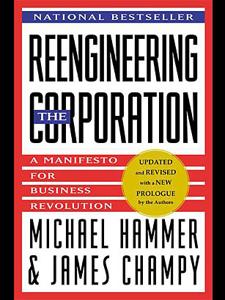
Want to learn the ideas in Reengineering the Corporation better than ever? Read the world’s #1 book summary of Reengineering the Corporation by Michael Hammer, James Champy here.
Read a brief 1-Page Summary or watch video summaries curated by our expert team. Note: this book guide is not affiliated with or endorsed by the publisher or author, and we always encourage you to purchase and read the full book.
Video Summaries of Reengineering the Corporation
We’ve scoured the Internet for the very best videos on Reengineering the Corporation, from high-quality videos summaries to interviews or commentary by Michael Hammer, James Champy.
1-Page Summary of Reengineering the Corporation
Far from a Fad: Reengineering for the Twenty-First Century
Reengineering has been around for a long time. In fact, it’s still being used by many companies today. Some of the companies that use reengineering are IBM, American Express, American Standard, Ford Motor Company and Chrysler Corporation. Reengineering is an important part of why these companies are so successful even though prices have fallen over the years; they’ve stayed profitable because of reengineering.
Reengineering has been criticized because it was so successful, and bandwagon jumpers claimed to be reengineering when they weren’t. Reengineering became a buzzword without much meaning. As a result, the people who criticize reengineering often aren’t referring to what real reengineers do at all.
Reengineering has been around for a long time. It allows companies to communicate better with each other and streamline their processes. Now, reengineering is being used to connect businesses together in order to share information more effectively. Reengineering isn’t going anywhere anytime soon; IBM just recently went through the process of reengineering itself, and it’s now starting over again because it wants its business operations to be Web-enabled.
The Continuing Crises
Ironically, American companies need reengineering because their old way of doing business succeeded. American corporations profited by implementing the ideas of Adam Smith, a famous economist who first outlined the principle of specialization and division of labor. Smith observed that by dividing a manufacturing process into several steps and giving each worker responsibility for one step, an individual could make more pins than if he did everything himself. Most American corporations are organized based on this principle. However, this structure has a price; it encourages people to focus on discrete parts rather than the whole process or its end result. One great consequence is that managers become distant from customers due to three important trends:
- Customers have more power than they used to. They can choose from a wide variety of products, and if they don’t like them, they can go elsewhere. It’s the same with services as well. Customers are also very demanding when it comes to quality and economy nowadays. Competition is also fierce in many industries because there are now so many other options for consumers besides just one company or product. And change happens all the time! In fact, companies need to be constantly changing their strategies so that they keep up with new trends in business and technology.
Reengineering and Change
Reengineering is a radical change in how you do business. You must ask the most basic questions about your current processes to determine whether they need changing. Most businesses have developed certain rules and assumptions that govern their operations over time, but these may not be necessary or efficient. Asking why things are done the way they are can help you see which processes could be changed for the better.
Reengineering means getting to the root of things. It’s about starting with a blank slate and building from the ground up. Reengineering is not about making small changes; rather, it means abandoning what works in favor of something that will work even better.
Most businesspeople focus on the job or the people, but not processes. All too often, however, they don’t consider how their end product creates value for their customers. Reengineering focuses on improving this process and creating a better outcome for the customer.
Several themes emerge from the reengineering of organizations, including: * Process – Ford, IBM Credit and Kodak improved their business operations by reengineering whole processes. Despite segmented organizational boundaries, they were able to make significant improvements in their businesses. * Ambition – Ford could have made a modest 20% improvement in its operation but instead opted for an 80% improvement.





